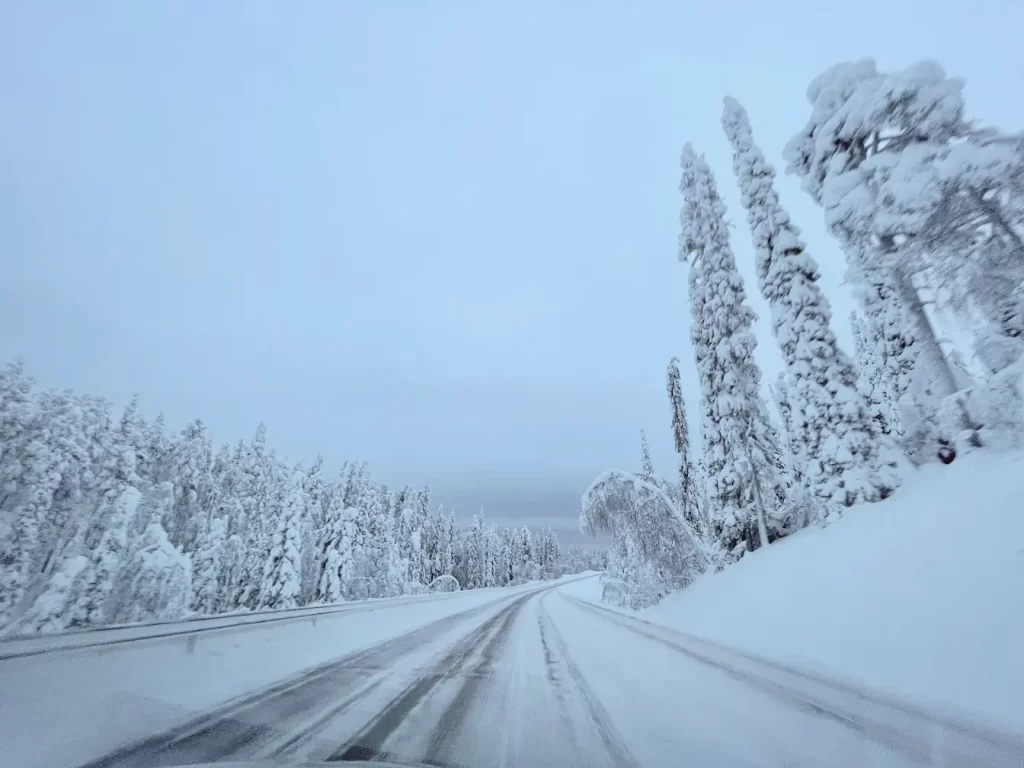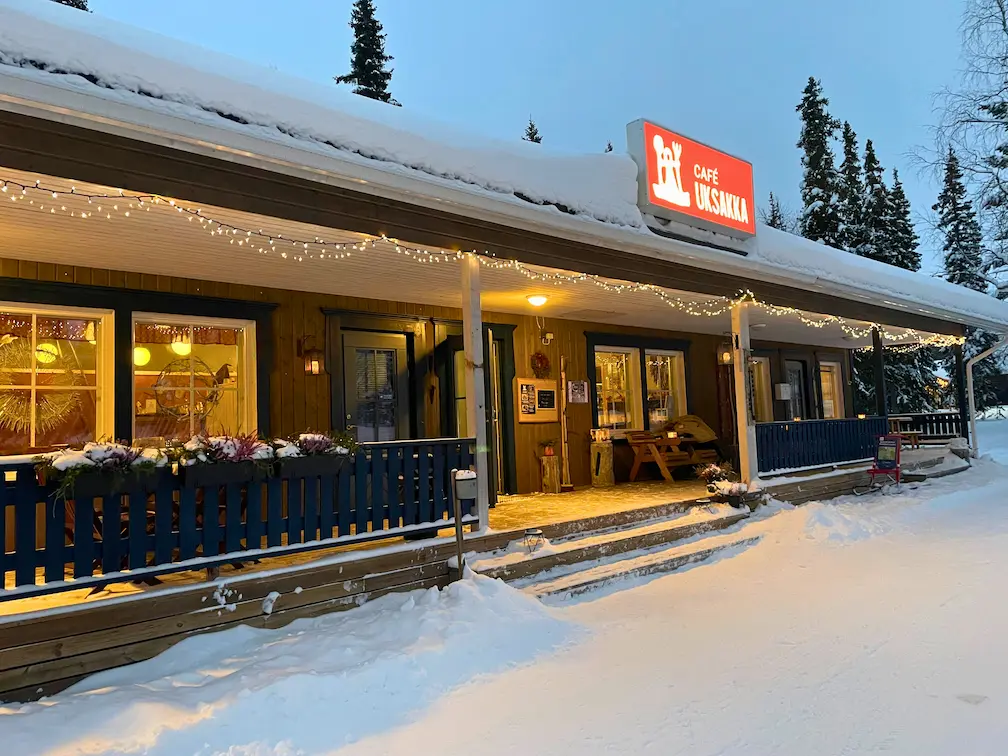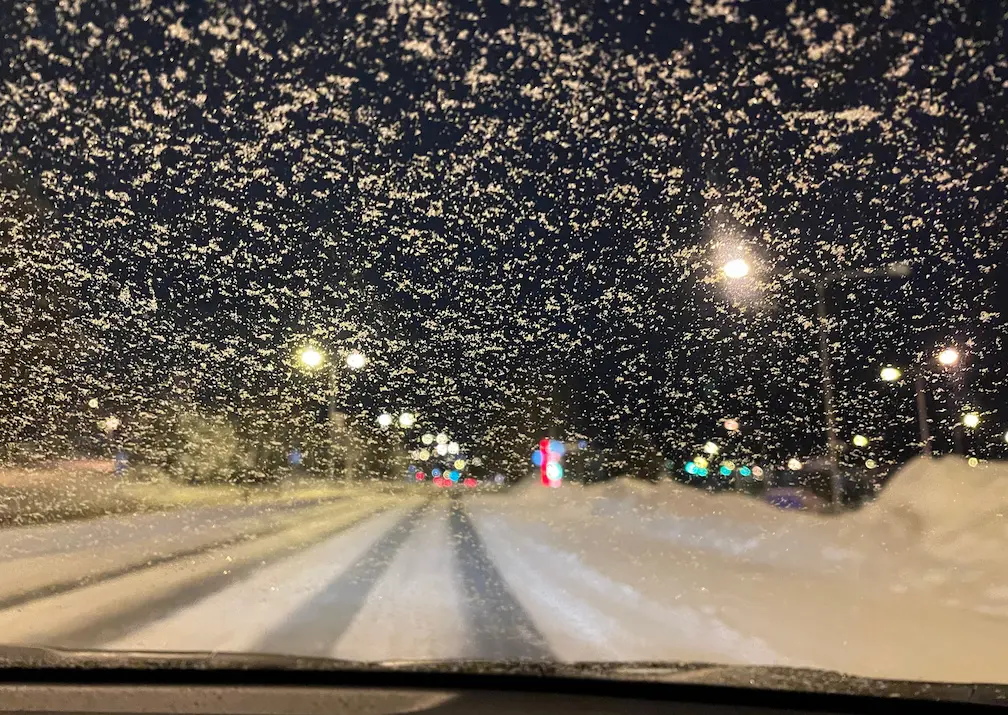Planning a trip to Lapland? Wondering if it’s safe to drive there in winter? The short answer: yes, absolutely—it’s safe, and it can even be great fun. I discovered this myself, and I actually prefer having the flexibility of a rental car. That said, driving in snowy Arctic conditions is a bit different from cruising down a dry highway. So if you’re considering a road trip to Lapland, here are some essential tips to keep you safe (and sane) behind the wheel. Let’s dive in!
✅ Check prices and book your rental car HERE!
What You'll Find In This Post:
1. Watch out for reindeer
Believe it or not, there are more reindeer than people in Lapland. You’re very likely to spot them on or near the roads, especially around sunrise and sunset—when visibility drops and the animals are most active.
In winter, that means roughly between 9:30 AM and 3:00 PM. If you see a reindeer ahead, brake firmly—but don’t swerve. Reindeer tend to panic under headlights and might run in unpredictable directions, sometimes alongside your car. Just stop and wait—it usually takes them a few moments to clear the road and disappear into the wilderness.
👉 Another useful tip: locals often flash their high beams to warn you of animals or other road hazards ahead, so keep an eye on oncoming traffic for helpful signals.
2. Maintain a safe distance
You should always leave space between you and the car in front—but in Lapland, it’s essential. Even though the main roads are in an excellent condition and they’re cleaned multiple times a day, a fine layer of snow often remains, and it gets kicked up into a mist by other vehicles. That “snow fog” can make it really hard to see.
By leaving plenty of space, you let the snowy mist settle before it reaches your windshield. Plus, it gives you more time to react if the car ahead suddenly stops—or if a reindeer dashes out of the trees.

3. Don’t Overtake Unless It’s Completely Safe
Overtaking on snowy or icy roads is risky at the best of times—and even more so in wintery, unfamiliar terrain. Add low light, a rental car you’re not used to, and wildlife, and it’s a recipe for trouble if you’re not cautious.
Stick to overtaking only when the road is long, straight, and clearly free of oncoming traffic. Most places you’ll visit in Lapland are within a 100 km (60 miles) radius of Rovaniemi or your accommodation, so if you get stuck behind a slow-moving vehicle, take a breath, maintain distance, enjoy the view and wait for a safe opportunity to pass it.
You’ll get there a few minutes later—but for that, you’ll be safe and sound and won’t ruin your vacation.
4. Lose 10 km/h—On Purpose
This is one of the simplest and most effective tips: once you’ve judged a safe speed for the road, drop it by 10 km/h (around 6 mph). For example, if you think 90 km/h is okay, drive at 80 instead.
Those extra seconds of reaction time can make all the difference if you suddenly need to brake or avoid an obstacle. Plus, speed limits in Lapland are often 80–100 km/h anyway, and driving a bit slower won’t ruin your day—but it could save it.
5. Dealing with Icy Roads
While Lapland’s roads are generally well maintained, icy patches do happen—especially in shaded areas or side roads.
🤓 Fun Fact: Finland doesn’t use salt on the roads because it attracts reindeer (yes, really!). So don’t expect the roads to be wet or slushy like they might be in other snowy places.
The good news? All rental cars in Lapland are legally required to have studded winter tyres. These offer impressive grip even on compacted snow and light ice.

6. Use the Finnish Traffic Service (Fintraffic)
Before heading out, check the Fintraffic website. It provides live updates on road conditions, maintenance work, closures, and traffic jams. They also have a traffic map where you can filter the information you want and, for example, check for any closures up to 10 hours in advance.
Another feature that I find truly fascinating is that you can access a ton of road condition cameras and see the road surface temperature in real time.
Avoid relying solely on Google Maps or your usual navigation app. They might route you through less-maintained roads in winter, or even technically closed. Always double-check your route using Fintraffic before heading out, and if in doubt, ask your hotel or a local. Most locals speak excellent English and are happy to help.

7. Don’t Hug the Right Side of the Road Too Closely
It might feel safer to stick close to the right edge of the road, especially if you’re worried about oncoming traffic. But that can be a mistake.
Snowploughs can’t always clear the edges perfectly, and the far right of the road may have loose, powdery snow. If your wheels hit that soft snow at speed, your car could drift or slide into a ditch. If you do feel yourself moving into it, don’t jerk the wheel. Ease off the accelerator, brake gently, and steer back to the middle of your lane with smooth, gradual movements.
Making any sudden or sharp turns at the point where you’ve just entered the build up snow will most likely end in a disaster.
Bonus Tips – Fuel and Rest Stops
Fuel:
When it comes to fuel, fill up more often than you think you need to. In remote areas, petrol stations can be few and far between, and some don’t operate 24/7. It’s not a bad idea to take a mental note of fuel stops on your way out, especially if you’re doing circular day trips.
Rest Stops & Roadside Culture in Lapland
One of the unexpected joys of driving around Lapland is stumbling across a cozy café or quirky roadside restaurant in the middle of nowhere. These places are usually spotless, warm, and weirdly charming, offering everything from reindeer burgers to cinnamon buns and excellent coffee (Finns take their coffee very seriously).
We stumbled across one café like this in the tiny town of Luosto, about an hour drive from Rovaniemi. It only served reindeer meat in different forms – burger, kebab, sautéed etc. – but the staff were incredibly friendly and the food tasted great!

You’ll also find clean toilets—even in smaller petrol stations—and play corners for kids. It’s well worth planning your route around a couple of these pit stops, especially on longer drives.
They give you a break from the wheel, a chance to stretch your legs, and maybe even the odd souvenir or reindeer keyring to commemorate the trip.
How to drive in the dark
One thing that surprises many visitors: it’s basically always dark in Lapland during deep winter. The sun rises late and sets early—if it rises at all. That means most of your driving will be in low light, twilight, or full-on night mode.

Your headlights and windscreen wipers are your best friends. Keep your lights on at all times, clean off any snow or grime regularly, and don’t forget the rear lights too. Be prepared for that eerie glow of white snow reflecting the beams back at you—it can make the edges of the road a little harder to judge.
Drive slower than you normally would and stay sharp. It can be a bit intense at first, but you can adjust quickly.
👉 Oh, and bring sunglasses. Yes, really. When the sun does make an appearance, it sits low on the horizon and reflects off the snow like a spotlight straight into your eyes.
Do You Really Need a Car in Lapland in Winter?
That depends on the kind of trip you’re planning. If you’re staying in Rovaniemi and sticking to organised excursions—like husky sledding, visiting Santa Claus Village, or chasing the Northern Lights with a tour company—you could get away without a car. Many tours include pick-up from your accommodation, and the town itself is small enough to get around by foot or taxi.
However, if you’re after more flexibility and want to explore off-the-beaten-path gems—like frozen lakes, remote saunas, or scenic national parks—a car makes a huge difference. Public transport is limited, and waiting for buses in -20°C isn’t the most magical experience.
Having a car gives you the freedom to stop for photo ops, linger in lovely cafés, or just follow the snow-dusted road to wherever it leads. Yes, driving in winter can be intimidating at first, but with the right prep (and studded tyres), it’s totally doable—and often part of the adventure.
❄️ Check out the BEST day trips from Rovaniemi here!
Final Thoughts: Is Driving in Lapland Worth It?
Absolutely. Having a car in Lapland gives you the freedom to explore at your own pace—from chasing the northern lights to reaching remote saunas or frozen waterfalls.
Yes, it’s a different kind of driving—slower, quieter, and definitely snowier—but it can also be part of the adventure. Just respect the conditions, stay alert, and don’t rush.
And remember: if you run into serious trouble or an emergency, the number for emergency services in Finland is 112.
Stay safe and enjoy the ride!
FAQ: How To Safely Drive in Lapland in Winter
Is it safe to drive in Lapland during winter?
Yes, it’s safe if you take proper precautions. Roads are well-maintained, and rental cars come equipped with studded winter tyres. Just drive cautiously and stay alert.
Do rental cars in Lapland have winter tyres?
Yes, by law, all rental cars in Lapland are fitted with studded winter tyres—giving you extra traction on snow and ice.
Can reindeers cross the roads?
Yes, especially around sunrise and sunset. Always brake gently and avoid swerving. Wait for the animal to clear the road.
What’s the speed limit in Lapland during winter?
Most roads are limited to 80 km/h. It’s a good idea to drive 10 km/h slower than what feels safe to allow for better reaction time.
Is GPS reliable in Lapland?
Google Maps works, but it can sometimes suggest routes that aren’t winter-maintained. Use the Fintraffic website for safer route planning.
Can I drive in Lapland without prior snow-driving experience?
Yes, many tourists do. Just take it slow, don’t overtake unnecessarily, and follow local driving advice. It helps to have a confident but cautious mindset.
What’s the emergency number in Finland?
Dial 112 for any emergency—accidents, car trouble, or wildlife incidents.
Recent Posts
Getting to Levi from Helsinki - Four Ways to Reach the Heart of Lapland
Levi, perched on the slopes of the Sámi‑named “Levi” mountain in Finnish Lapland, has become one of Scandinavia’s premier winter‑sport destinations. Beyond skiing and...
Getting from Helsinki to Rovaniemi—Four Ways to Reach the Arctic Capital
Rovaniemi, the official hometown of Santa Claus and the gateway to Finnish Lapland, sits roughly 800 km north of Finland’s bustling capital, Helsinki. Whether you’re chasing the Northern Lights,...



